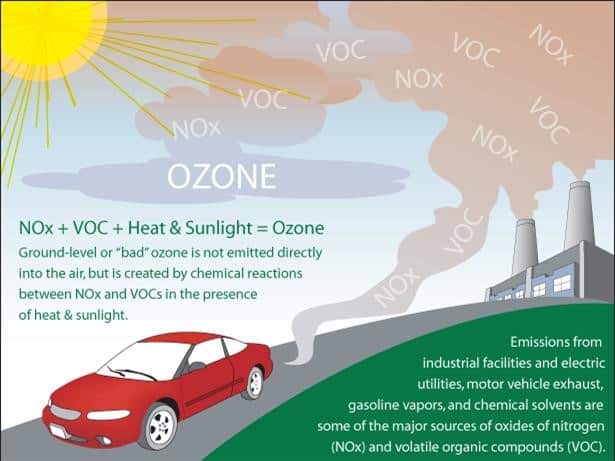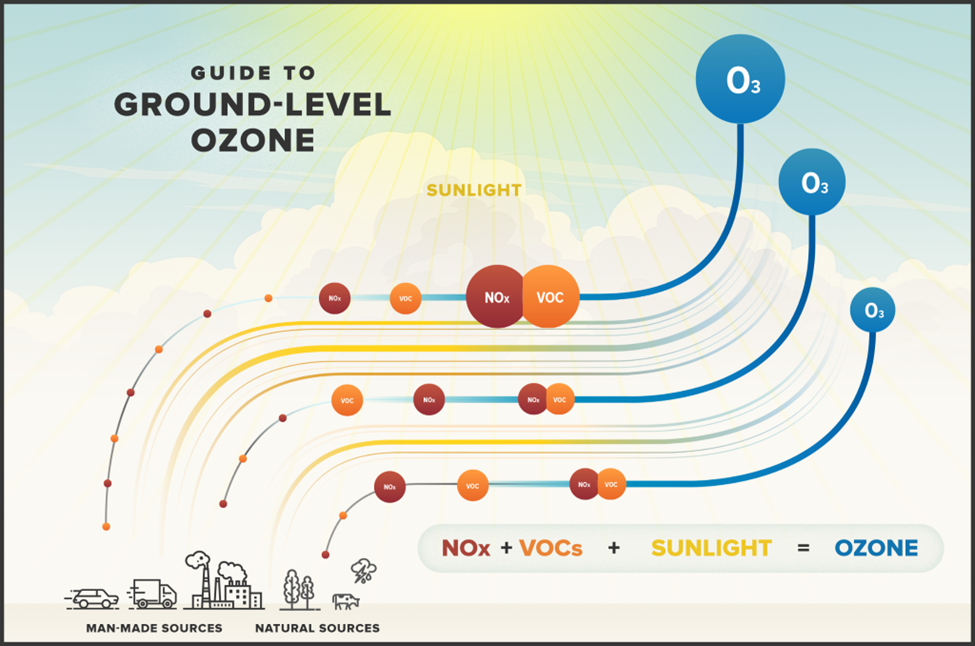What’s in today’s article?
- Why in News?
- What is Ground-level Ozone?
- What are the Harmful Effects of Ground-level Ozone?
- What is the Situation of Ground-level Ozone in India?
Why in News?
- According to the Centre for Science and Environment (CSE), parts of the Delhi-NCR region witnessed ground-level ozone readings exceeding the safe standards (50 ppb over an 8-hour average) between March and May.
- Moreover, the region is seeing a rare phenomenon where ozone levels remain elevated even at night (should ideally become negligible during the night) and has become a yearlong problem.
What is Ground-level Ozone?
- Also known as tropospheric ozone, ground-level ozone is a colourless and highly irritating gas that forms just above the Earth’s surface (up to 2 miles above the ground).
- Ground-level ozone is a “secondary” pollutant – not directly emitted into the air but rather produced when two primary pollutants react in sunlight and stagnant air.
- These two primary pollutants are nitrogen oxides (NOx) and volatile organic compounds (VOCs).
- NOx and VOCs come from natural sources as well as human activities.
- About 95% of NOx from human activity comes from the burning of coal, gasoline and oil in motor vehicles, homes, industries and power plants.
- VOCs from human activity come mainly from gasoline production and combustion, residential wood combustion and from the evaporation of liquid fuels and solvents.
- Ground-level ozone is likely to breach safety standards on hot summer days in urban areas, but can also reach unhealthy levels during colder months.
- The pollutant can also travel long distances due to wind and affect rural areas also.
What are the Harmful Effects of Ground-level Ozone?
- On human health:
- As ground-level ozone is a highly reactive gas, it has serious health consequences.
- Those with respiratory conditions, asthma, chronic obstructive pulmonary disease and particularly children with premature lungs and older adults are at serious risk.
- This can inflame and damage airways, make lungs susceptible to infection, aggravate asthma, emphysema, and chronic bronchitis leading to increased hospitalisation.
- The pollutant can affect sensitive vegetation and ecosystems: Including forests, parks and wildlife refuges. Significantly, it can harm sensitive vegetation during the growing season too.
What is the Situation of Ground-level Ozone in India?
- In recent years, ground-level ozone has become a serious public health issue in India.
- According to the 2020 State of Global Air report,
- Seasonal 8-hour daily maximum concentrations have recorded one of the highest increases (17%) in India between 2010 and 2017.
- Age-standardised rates of death attributable to ground-level ozone are among the highest in the country.
Q1) What is the National Clean Air Programme (NCAP)?
NCAP targets to achieve reduction in PM10 levels up to 40% or achievement of national standards (60 microgram/cubic meter) by 2025-26 in targeted 131 cities of 24 States.
Q2) What is the Graded Response Action Plan (GRAP)?
GRAP was notified in 2017, for prevention, control and abatement of air pollution in Delhi and NCR. It identifies graded measures and implementing agencies for response to four AQI categories, namely, Moderate to Poor, Very Poor, Severe and Severe + or Emergency.
Last updated on December, 2025
→ Check out the latest UPSC Syllabus 2026 here.
→ Join Vajiram & Ravi’s Interview Guidance Programme for expert help to crack your final UPSC stage.
→ UPSC Mains Result 2025 is now out.
→ UPSC Notification 2026 is scheduled to be released on January 14, 2026.
→ UPSC Calendar 2026 is released on 15th May, 2025.
→ The UPSC Vacancy 2025 were released 1129, out of which 979 were for UPSC CSE and remaining 150 are for UPSC IFoS.
→ UPSC Prelims 2026 will be conducted on 24th May, 2026 & UPSC Mains 2026 will be conducted on 21st August 2026.
→ The UPSC Selection Process is of 3 stages-Prelims, Mains and Interview.
→ UPSC Result 2024 is released with latest UPSC Marksheet 2024. Check Now!
→ UPSC Prelims Result 2025 is out now for the CSE held on 25 May 2025.
→ UPSC Toppers List 2024 is released now. Shakti Dubey is UPSC AIR 1 2024 Topper.
→ UPSC Prelims Question Paper 2025 and Unofficial Prelims Answer Key 2025 are available now.
→ UPSC Mains Question Paper 2025 is out for Essay, GS 1, 2, 3 & GS 4.
→ UPSC Mains Indian Language Question Paper 2025 is now out.
→ UPSC Mains Optional Question Paper 2025 is now out.
→ Also check Best IAS Coaching in Delhi


















